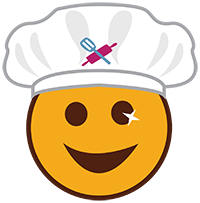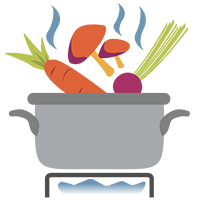Creamy Cozy Corn-Cocoa "Champurrado" Mugs

Creamy Cozy Corn-Cocoa "Champurrado" Mugs
Thick, silky hot cocoa that’s thicker, creamier, and even more chocolatey than your average cup!
Happy & Healthy Cooking,
Fun-Da-Mentals Kitchen Skills
- measure :
to calculate the specific amount of an ingredient required using a measuring tool (like measuring cups or spoons).
- simmer :
to cook a food gently, usually in a liquid, until softened.
- whisk :
to beat or stir ingredients vigorously with a fork or whisk to mix, blend, or incorporate air.
Equipment Checklist
- Large pot
- Dry measuring cups
- Liquid measuring cup
- Measuring spoons
- Whisk
Ingredients
Creamy Cozy Corn-Cocoa "Champurrado" Mugs
- 4 C water
- 1/2 C granulated sugar
- 1 tsp ground cinnamon
- 2 T pure unsweetened cocoa powder **(for DAIRY ALLERGY check label for small amounts of dairy; for CHOCOLATE ALLERGY sub carob powder)**
- 1/8 tsp mild chili powder **(Omit for NIGHTSHADE ALLERGY)**
- 1/4 C corn masa flour
- extra seasoning and water if needed for consistency and flavor
Food Allergen Substitutions
Creamy Cozy Corn-Cocoa "Champurrado" Mugs
- Chocolate: Check cocoa powder labels for small amounts of dairy. Substitute carob powder for cocoa powder.
- Nightshade: Omit mild chili powder.
Instructions
Creamy Cozy Corn-Cocoa "Champurrado" Mugs
measure + whisk
In a large pot, measure 4 cups water, 1/2 cup sugar, 1 teaspoon cinnamon, 2 tablespoons cocoa powder, 1/8 teaspoon mild chili powder, and 1/4 cup corn masa flour. Whisk this mixture thoroughly. You want to whisk until the seasoning and corn flour are fully mixed in with no lumps.
simmer + pour
Bring the mixture to a simmer for 10 minutes over medium low heat. While you stir and wait, let’s practice counting to 10 in Spanish: 1 uno (OOnoh), 2 dos (dohs), 3 tres (trehs), 4 cuatro (KWAHtroh), 5 cinco (SEENkoh), 6 seis (SAYees), 7 siete (seeEHtay), 8 ocho (OHchoh), 9 nueve (NUehvay), 10 diez (DEEehs). You can always add more seasonings or water for the proper consistency and flavor. Enjoy and “salud” (Sah-LOOD) or “cheers” in Spanish!

Hi! I'm Corn Masa Flour!
"I'm also called Masa Harina. You can use me to make gorditas, pupusas, sopes, tamales, and tortillas! You can even add corn masa flour to soups, cakes, and cookies! Did you know "masa" means "dough" or "mass" and "harina" means "flour" in Spanish?"
- Corn masa flour is dehydrated (dried) corn masa, a dough made from finely ground corn kernels cooked and soaked in limewater (calcium hydroxide), an alkaline solution. This process, called "nixtamalization," was developed in Mesoamerica about 3,000 years ago and gives the masa a distinctive flavor. Let's say it together: nis-TUH-mal-uh-zay-shun. You got it!
- When you add water back into the flour, it becomes masa, or dough, again. Of course, you can use fresh masa, but it can take a few hours to simmer and soak the dried corn kernels and then grind them in a food processor. It is much quicker to get a bag of masa harina at the market and just add water!
- Corn masa flour has protein, fiber, B vitamins, potassium, calcium, and magnesium.
What is "Champurrado"?

- “Champurrado” is the chocolate version of the thick, hot Mexican drink “atole,” made with corn masa dough or masa harina (dried corn masa flour). Ingredients include chocolate or cocoa, masa harina, “piloncillo” (unrefined whole cane sugar), cinnamon, anise seed or vanilla, and water or milk. Orange zest and other spices may also be added.
- Champurrado is traditionally mixed using a “molinillo,” a wooden whisk that is turned back and forth between the palms of the hands until the drink is frothy. A wire whisk or blender may also be used.
- The drink is often served with churros for breakfast or snacks. It is also popular during the Day of the Dead and Las Posadas celebrations.
Let's Learn About Mexico!

- Officially, Mexico's name is "The United Mexican States." It is one of several countries and territories in North America, including Canada and the United States of America.
- Spanish is Mexico's national language, and Mexico is the largest Spanish-speaking country in the world. Mexican people didn't always speak Spanish, though. For thousands of years, Native Americans lived there and built great cities. The people had advanced language, education, and calendar systems, and they had very clever ways of raising food. Mexico is also the country with the largest number of native American speakers in North America.
- The capital of Mexico is Mexico City. Mexican legend says that Aztec leaders were told to build their great city of Tenochtitlan at the site where they saw an eagle sitting on a nopal cactus with a snake in its beak. That image is in the center of Mexico's flag. The Aztecs built their city on an island in the middle of a lake. The ruins of Tenochtitlan are at the center of Mexico City and still sit on top of a lake! As water is pumped out to serve the needs of the city's growing population, the city has been sinking at a rate of 6 to 8 inches per year.
- Indigenous Mexican people included the Aztecs in the central interior of the country, the Mayans of the Yucatan peninsula, and the Zapotec of the south. Spanish explorers landed in Mexico in the early 1500s, and they ruled Mexico for over 300 years. During this time of colonization, Mexico's Mesoamerican civilizations mixed with European culture.
- Before the arrival of Spaniards, native Mexican food primarily consisted of corn, beans, peppers, tomatoes, sweet potatoes, squash, and herbs. Indigenous people occasionally hunted and added wild turkey, rabbit, deer, and quail to their largely vegetarian diets. Native royalty sipped chocolate drinks. Europeans introduced cattle, sheep, pigs, goats, chickens, sugarcane, and wheat to Mexico upon their arrival.
- Mexican cuisine uses chili peppers to give it its distinct flavor. Jalapeños, poblanos, and serrano peppers are commonly used in Mexican dishes. Dishes that include mole, a sauce made of dark chocolate, chili peppers, cinnamon, and other spices, may be served on special occasions, such as Día de los Muertos.
What is it like to be a kid in Mexico?
- Mexican children may live near the ocean or the gulf, in the desert, or in the mountains.
- Kids often live with extended family, including grandparents. Their full names include their father's and their mother's.
- Most kids speak Spanish, but Mexico also recognizes 68 native languages.
- They attend school from September through June. Large schools have two shifts—one group in the morning and one in the afternoon. Students are usually required to wear uniforms.
- They may play soccer, baseball, and other sports. Jumping rope and other outdoor games are very popular. They might play a game similar to bingo called Lotería. It is played with picture cards and songs.
- Corn tortillas are a staple for kids, along with beans and rice. Dishes that include mole, a sauce often made of dark chocolate, chili peppers, cinnamon, and other spices, may be served on special occasions.
- A popular family holiday is Día de los Muertos (Day of the Dead), a celebration to remember and honor a family's ancestors. Family members decorate the graves of their relatives who have passed on. Typical foods served for this holiday include empanadas, tamales, pan de muertos (a sweet bread in which a ring with a tiny plastic skeleton is hidden), and calaveras de azucar (sugar candy skulls).




